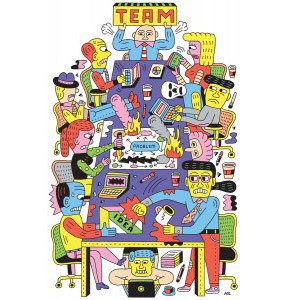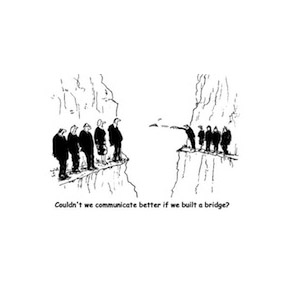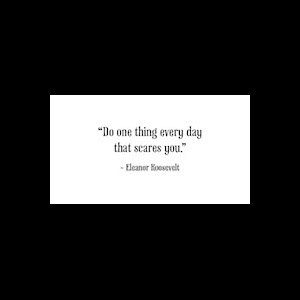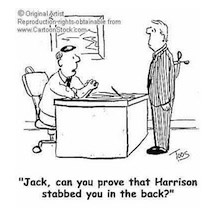 Are you an introvert or an extrovert? The business world has always rewarded extroverts, from Groupthinks and brainstorming to social outings and even cubicle farms.
Are you an introvert or an extrovert? The business world has always rewarded extroverts, from Groupthinks and brainstorming to social outings and even cubicle farms.
But, as it turns out, introverts make up half the business population and a lot is being written about the differences between the two personality types and how they can live (and work) together in harmony.
Susan Cain, Lisa Petrilli, and Clive Thompson all discuss introverts in today’s workplace.
Traditionally, extroverts have been viewed as having greater success in all aspects of life.
In the workplace, specifically, it has been thought that one could only achieve success if they were outgoing and able to work well in a team environment.
However Susan Cain, author of the new book, Quiet: The Power of Introverts in a World That Can’t Stop Talking, argues that “forcing everyone to act like extroverts harms the quality of our work and our lives.”
Nearly a third of Americans are introverts. These people typically have the profound ability to stay focused and work diligently, but often find themselves overwhelmed by too much forced socializing thanks to team-based work environments and face-to-face collaboration.
Forced socialization can become detrimental to their productivity, causing them to suppress their ideas and thoughts.
So what’s the alternative? Cain suggests the answer is “virtual” collaboration. This is the idea that individual team members work alone prior to discussing solutions with the rest of their team. It is believed that working in this manner yields better results.
The interesting thing about all of this and which Thompson points out in this article, is virtual collaboration is very similar to how people collaborate online. There are a plethora of outlets for which people can interact with one another, but it can be done in private and you can give yourself time to reflect and respond. Cain says that this is “precisely what brings out the best in introverts.”
How well do you know the people you work with and how are you structuring your brainstorming meetings? Do you feel you could be getting more out of these meetings? If you aren’t completely happy with the results coming out your current brainstorming sessions, perhaps it might be time to consider taking this approach to team collaboration.
You never know…a new superstar might emerge with some incredible ideas.
 Do you ever think about taking all the great leaders you’ve had the pleasure of working for or with and putting them in one room for a day?
Do you ever think about taking all the great leaders you’ve had the pleasure of working for or with and putting them in one room for a day?
What if you took all the traits that made each of them who they are and combined them into one person, creating a sort of all-star team of leadership traits?
Gretchen Rosswurm's article Leaders Communicate and Communicators Lead inspired this idea.
She looked at the many executives she’s worked with over the years and drew some common denominators.
What would you add? What great leaders inspire you?
Thanks to Eyetalk for the image.
 You know the expression well; it's lonely at the top.
You know the expression well; it's lonely at the top.
Every leader deals with self-doubt, fear of making the wrong decision, and other potentially limiting behaviors.
The key is "potentially" because some leaders deal with these emotions well, while others don't.
Leadership coach Art Petty shares the realities of leading others and offers steps for moving past the limiting behaviors. One of the most important things to remember is, even though it feels lonely, no leader is alone in dealing with these issues.
So, what do to?
No one said leading was going to be easy. Many entrepreneurs are born from a passion for the business, and weren't prepared for the bigger tasks at hand; leading a team.
Photo by OzinOH.
 An interesting headline in the Harvard Business Review blog network caught my attention: What Captures Your Attention Controls Your Life.
An interesting headline in the Harvard Business Review blog network caught my attention: What Captures Your Attention Controls Your Life.
Chaos is the term that might come to mind, in this day and age, when it's hard to keep attention focused on any single task or project; when we have notifications pinging on devices and numerous windows open on our computer desktops at any given time.
Stop and take a look now. How many do you have open?
In the article, author Kare Anderson shared a study Disney World had hired her to conduct a few years ago - to see what captured the attention of children in their amusement park.
She and her team went in to observe how kids reacted to the cast members, rides, concessions, and multiple stimuli throughout the park.
What do you think most captured the children's attention? Their parent's cell phones. When their parents were using them.
We don't think about it - we think we can give everyone the attention they deserve and desire, but our kids, and our teams are the real judges. They can tell us if we're doing a good job of it or not.
The best thing you can do? Give undivided attention. Be the best listener ever.
Who are some of your closest friends? The ones you enjoy most spending time with? I'd be willing to bet they are the friends who listen to you and care about you.
Listening, explained Anderson, is the "social cement" and the foundation for the best relationships. It makes the other person feel valued, and opens you up to a new world of ideas.
What would you add?
 When things aren’t going to plan, it’s a common, knee-jerk reaction to first point blame somewhere else. It can't possibly be our own fault, right?
When things aren’t going to plan, it’s a common, knee-jerk reaction to first point blame somewhere else. It can't possibly be our own fault, right?
Monica Wofford wrote an interesting post about inconsistent leadership which requires us as leaders, to look within when employers are underperforming.
It’s an interesting concept, because the first reaction is to blame the underperforming employee, of course, and to think about termination or relocation to a different department.
Did you ever stop to think it could be your own fault?
According to Wofford, an inconsistent leader is hot and cold; good mood, bad mood; approachable, frightening; empathetic, ruthless.
Think of it from your team’s perspective and you can start to see why it would affect performance.
Awareness is the first step in dealing with inconsistent leadership. See the problem and tackle each one of these one by one. Practice mindfulness and keeping your mood steady.
Remember your mood affects everyone. You don't have the luxury in indulging in mood swings. And talk to your staff. If you find you need to make changes, approach it together. You’re not alone. Everyone wants to like everyone they work with.
Don't you agree?
 Strong relationships have always been important in the workplace. As businesses become global and professionals work together across time zones, managing and maintaining workplace relationships has become challenging.
Strong relationships have always been important in the workplace. As businesses become global and professionals work together across time zones, managing and maintaining workplace relationships has become challenging.
The manager-employee relationship has a critical affect on performance. Smart business leaders know if managers are trained and charged with responsibility for the success of their reports, departmental and organizational performance will take care of itself.
Companies that don’t drive home the importance of this relationship to frontline managers will eventually pay the price, whether it’s in the loss of good employees or decreases in performance resulting from employee dissatisfaction.
Ming Ong wrote an article entitled “How to Find Balance Between Leadership and Management,” and it dives into how to build positive relationships. As business leaders and managers, we need to build and foster positive relationships with our employees.
Employee Awareness
Don’t just act interested, be interested. Ong suggests to keep in regular contact with your employees and really hear what they are doing as well as what they have on their plate. If you take a sincere interest in your employees, they will feel you are truly interested in them and they’ll be more dedicated to their work and the company’s success.
Accountability
Employees need to be held accountable for their tasks. For a group of employees to work together, they need to understand group and individual goals. Understanding shared and individual goals eliminates finger-pointing because everyone understands the relevance of the teams contributions. This provides employees with increased awareness of their interdependencies.
Empowerment
Offer guidance, but let your employees make the decisions when possible. They will feel valuable and it encourages them to learn more and grow. Inspire, don’t control. Encourage feedback, and communicate what is happening. People want to know their input matters and how they contribute to the company’s success.
What our businesses need today are managers who lead, inspire, and motivate employees to achieve business-wide goals. In the long-term, building solid relationships with employees builds an environment where they want to meet their goals and are not forced to do so.
 Eleanor Roosevelt’s famous quote reminds us to “do one thing everyday that scares you.” We all have different thresholds for fear, and different ways we process our fear.
Eleanor Roosevelt’s famous quote reminds us to “do one thing everyday that scares you.” We all have different thresholds for fear, and different ways we process our fear.
Overcoming fear also has a different meaning for each of us.
But fear can be paralyzing.
Inc. Columnist Geoffrey James wrote an interesting article about tricking yourself out of fear and into action. The idea is that we get the best results when we take big leaps. They may be one of the scariest times, and full of risk, but the outcome, one way or the other, is most rewarding.
Think about some of the biggest decisions you’ve made in your life; things that disrupted your status quo. I’d be willing to bet, even if the planned outcome wasn’t achieved, it opened other doors to new opportunities.
James said, “I’ve managed to retrain my brain to get past the momentary fear and push toward the payoff.”
I’d love to hear from you, now. What have you done lately to overcome fear?
Photo courtesy of Vale Design.
 We are all human; we all err. No one is exempt. As a leader, you’ll be more remembered for how you deal with your mistakes, than your actual mistake. Think about that.
We are all human; we all err. No one is exempt. As a leader, you’ll be more remembered for how you deal with your mistakes, than your actual mistake. Think about that.
Some of the greatest mistakes in business are more remembered for how they were handled. Think about Johnson and Johnson’s handling of the Tylenol situation, which was seen as positive despite the tragic situation. On the other hand, there is the BP oil spill which became a disaster for all involved because of the CEO’s poor handling of the situation.
In other words, you can make it worse, or you can make it better. It’s all in how you handle the aftermath of said mistake.
Art Petty shares tips to deal with your mistakes providing a great reminder on a number of levels. Most of all, he advises, rightly so, how you handle your mistakes is a great sign of your leadership abilities.
Maybe you’ll stop making mistakes? Don’t count on it. If we are afraid to make mistakes, it means we aren’t taking risks. The best outcomes happen after leaders accept responsibility, apologize, and outline how they will fix the problem.
Have you made a mistake recently? Do you want to practice here and tell us about it?
 Gossip at the water cooler, power plays by management, and bullying in the office.
Gossip at the water cooler, power plays by management, and bullying in the office.
While some leaders appreciate some office politics to create a sense of “survival of the fittest;” competition, others won’t accept it as part of the working environment because it negatively affects morale, turnover, and often, opportunities for star employees who might otherwise be very good, but don’t successfully “play the politics game.”
Skilled employees don't want to work where they can’t succeed on good performance and initiatives but must “play the game” to get ahead. So they look elsewhere.
Realistically, no work environment can be completely free of the politics. You have employees, who are human, with varying personalities, work ethics, and opinions.
Blinds.com chief executive officer, Jay Steinfeld says you can find a happy balance by creating an environment that encourages competition without the nastiness and jealousy involved in the office politics in his article for Inc.
By nature of leading a team of people, there will always be challenging interpersonal dynamics. Office politics won’t go away completely and forever. However, by leading by example, you show the type of working environment you want to foster; one which is competitive and open to healthy debate, but closed to negative attacks.
Do you have issues with office politics in your business? What do you do to keep it at bay?
